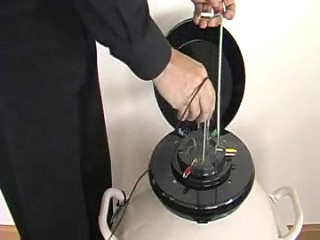Research Instruments, a biomedical technology company based in the U.K., has developed an RFID system that enables the identification of cryopreserved biological specimens, such as tissue, blood or sperm, without removing them from the liquid nitrogen tanks in which they are stored. To achieve this, the firm had to develop RFID inlays that can be read at temperatures as low as -196 degrees Celsius.
Research Instruments claims that other specimen RFID tags on the market can survive -196 degrees Celsius but need to be warmed up to -80 degrees in order to be read. This step, which requires the removal of the tagged specimens from the liquid nitrogen, puts the samples at risk of warming up too fast and being rendered unusable. It also adds time to the inventorying process.
The specimens are stored inside either plastic vials or straws. Sperm samples, for example, are placed in plastic vials, while oocytes or embryos are stored in plastic straws. “Our tags can be directly immersed in the liquid nitrogen without being damaged,” says Research Instruments’ managing director, William Brown. The company makes a number of different tools with applications in the biomedical and microelectronics industries, such as micromanipulators and probe needles. This is its first RFID product.
The vials or straws are bundled together into long, thin tubes called canes that are held in larger, long metal cones called goblets. A cane can hold up to 12 straws, a goblet can accommodate up to 12 canes, and a liquid nitrogen tank can contain up to 12 goblets. One Research Instrument tag is attached to each sample, either to the outside of the straw or vial or placed within it. Though the tag can be written to more than once, Research Instruments recommends that each tag be used only once to avoid misidentification through user error.
The tags are 2.4 millimeters in diameter and less than an inch long. They have a read range of approximately 10 centimeters, and each tag carries a unique ID number. The company would not divulge any other information regarding the tag—such as whether it is active or passive, how many bytes of data it can hold, at what frequency it operates or what standards it meets. This, according to Brown, is because the patent on the devices and the technology are pending. Research Instruments, which developed the technology behind the Cryoscan system, is outsourcing the manufacture of the tags to an unnamed provider. To read the tags, the Cryoscan system uses a Hewlett-Packard iPAQ Pocket PC PDA that is customized with an RFID reader and antenna, also from an unnamed provider.
To conduct inventories of the samples, a technician removes the stopper on the storage tank and passes the Cryroscan PDA/reader over the goblets while they are still submerged in liquid nitrogen. The reader identifies all of the samples in the tank without removing them, associates each specimen’s tag with its tank’s tag, and then sends this information wirelessly to the inventory database. This database can be maintained independently or can be integrated with a hospital’s or laboratory’s existing database systems. The Cryoscan reader can also search for a misplaced sample or alert the technician if a tag has been placed in a tank other than the one it has been assigned to in the database.
The main target applications for the Cryoscan system is identifying sperm samples—both human and animal (e.g., equine)—as well as identifying blood, drugs, proteins, tissue samples, cancer cells, etc. Any specimen that is stored in liquid nitrogen could be identified with the Cryoscan system. Pharmaceutical makers and companies that own large cryobanks, where samples of sperm, blood or transplantable tissues are stored, have approached Research Instruments with interest in using the Cryoscan system for specimen identification, but no relationships or contracts have been announced. The Cryoscan system is currently in clinical trails and will be available during the second quarter of 2005. No pricing information has been released.


